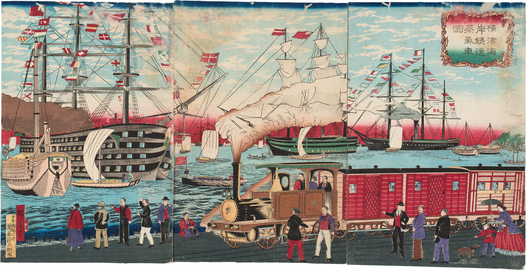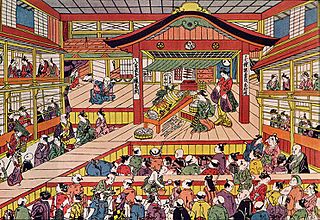
Ukiyo-e is a genre of Japanese art that flourished from the 17th through 19th centuries. Its artists produced woodblock prints and paintings of such subjects as female beauties; kabuki actors and sumo wrestlers; scenes from history and folk tales; travel scenes and landscapes; flora and fauna; and erotica. The term ukiyo-e translates as 'picture[s] of the floating world'.
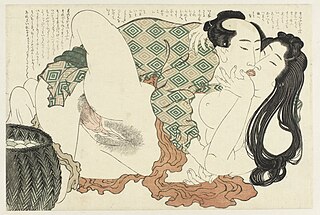
Shunga (春画) is a type of Japanese erotic art typically executed as a kind of ukiyo-e, often in woodblock print format. While rare, there are also extant erotic painted handscrolls which predate ukiyo-e. Translated literally, the Japanese word shunga means picture of spring; "spring" is a common euphemism for sex.
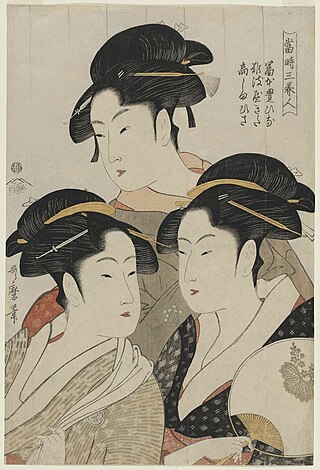
Bijin-ga is a generic term for pictures of beautiful women in Japanese art, especially in woodblock printing of the ukiyo-e genre.

Bunmei-kaika refers to the phenomenon of Westernization in Japan during the Meiji era (1868–1912), which led to major changes in institutions and customs. The term is generally used for the period in the early Meiji era when customs and manners changed drastically from the feudal society of the past. Under the influence of scholars such as Fukuzawa Yukichi, it was thought that adopting Western culture would allow Japan to overcome the perceived weaknesses of its traditional culture.
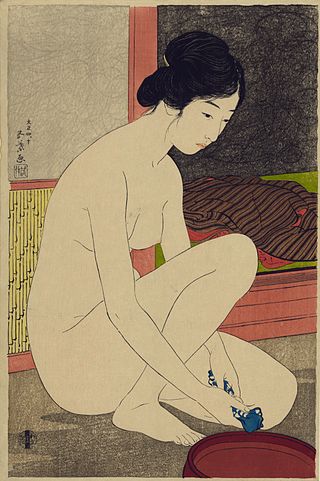
Shin-hanga was an art movement in early 20th-century Japan, during the Taishō and Shōwa periods, that revitalized the traditional ukiyo-e art rooted in the Edo and Meiji periods. It maintained the traditional ukiyo-e collaborative system where the artist, carver, printer, and publisher engaged in division of labor, as opposed to the parallel sōsaku-hanga movement.
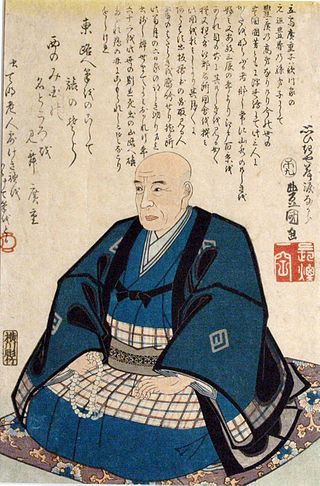
Utagawa Hiroshige, born Andō Tokutarō, was a Japanese ukiyo-e artist, considered the last great master of that tradition.

Toyohara Kunichika was a Japanese woodblock print artist. Talented as a child, at about thirteen he became a student of Tokyo's then-leading print maker, Utagawa Kunisada. His deep appreciation and knowledge of kabuki drama led to his production primarily of yakusha-e, which are woodblock prints of kabuki actors and scenes from popular plays of the time.

Adolfo Farsari was an Italian photographer based in Yokohama, Japan. His studio, the last notable foreign-owned studio in Japan, was one of the country's largest and most prolific commercial photographic firms. Largely due to Farsari's exacting technical standards and his entrepreneurial abilities, it had a significant influence on the development of photography in Japan.
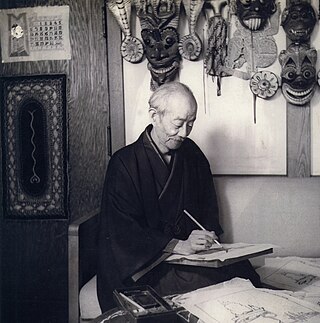
Hiroshi Yoshida was a 20th-century Japanese painter and woodblock printmaker. Along with Hasui Kawase, he is regarded as one of the greatest artists of the shin-hanga style, and is noted especially for his landscape prints. Yoshida made numerous trips around the world, with the aim of getting to know different artistic expressions and making works of different landscapes. He traveled widely, and was particularly known for his images of non-Japanese subjects done in traditional Japanese woodblock style, including the Taj Mahal, the Swiss Alps, the Grand Canyon, and other National Parks in the United States.
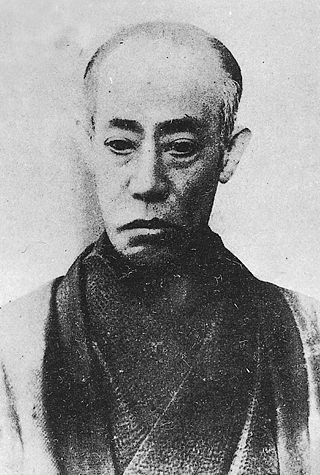
Ichikawa Danjūrō IX was one of the most successful and famous Kabuki actors of the Meiji period (1868–1912).

Toyohara Chikanobu, better known to his contemporaries as Yōshū Chikanobu (楊洲周延), was a Japanese painter and printmaker who was widely regarded as a prolific woodblock artist during the Meiji epoch.
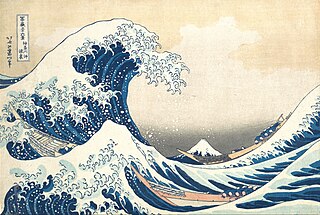
The Great Wave off Kanagawa is a woodblock print by Japanese ukiyo-e artist Hokusai, created in late 1831 during the Edo period of Japanese history. The print depicts three boats moving through a storm-tossed sea, with a large, cresting wave forming a spiral in the centre over the boats and Mount Fuji visible in the background.
Ogata Gekkō was a Japanese artist best known as a painter and a designer of ukiyo-e woodblock prints. He was self-taught in art, and won numerous national and international prizes and was one of the earliest Japanese artists to win an international audience.

Kobayashi Kiyochika was a Japanese ukiyo-e artist, best known for his colour woodblock prints and newspaper illustrations. His work documents the rapid modernization and Westernization Japan underwent during the Meiji period (1868–1912) and employs a sense of light and shade called kōsen-ga inspired by Western art techniques. His work first found an audience in the 1870s with prints of red-brick buildings and trains that had proliferated after the Meiji Restoration; his prints of the First Sino-Japanese War of 1894–95 were also popular. Woodblock printing fell out of favour during this period, and many collectors consider Kobayashi's work the last significant example of ukiyo-e.
Yokohama-e are Japanese woodblock prints depicting non-East Asian foreigners and scenes in the port city of Yokohama.
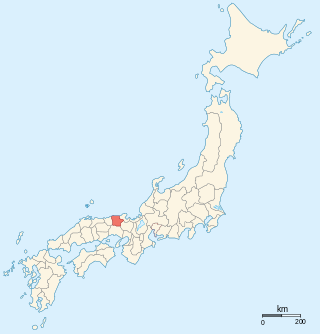
Utagawa Toyoharu was a Japanese artist in the ukiyo-e genre, known as the founder of the Utagawa school and for his uki-e pictures that incorporated Western-style geometrical perspective to create a sense of depth.
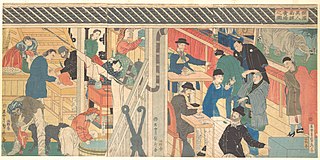
Utagawa Sadahide, also known as Gountei Sadahide, was a Japanese artist best known for his prints in the ukiyo-e style as a member of the Utagawa school. His prints covered a wide variety of genres; amongst his best known are his Yokohama-e pictures of foreigners in Yokohama in the 1860s, a period when he was a best-selling artist. He was a member of the Tokugawa shogunate's delegation to the International Exposition of 1867 in Paris.
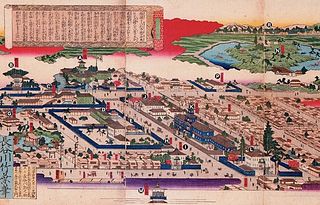
Hasegawa Chikuyō, also known under the art name Suiken Chikuyō, was a Japanese ukiyo-e print designer.

One Hundred Views of New Tokyo was a series of woodblock prints created from 1928 to 1932 by eight artists of the sōsaku hanga "creative print" movement.

Nagasaki-e is a genre of ukiyo-e woodblock prints, produced in Nagasaki during the Edo period, that depict the port city of Nagasaki, the Dutch and Chinese who frequented it, and other foreign curiosities such as exotic fauna and Dutch and Chinese ships. They were mostly produced for merchants who traveled to Japan on business. Japanese people also bought such prints as they were curious about foreigners, with whom they couldn't meet themselves. Nagasaki-e print were also sold in Edo, Osaka, and provinces. Nagasaki was the only port that foreigners were allowed to visit in Tokugawa time, between 1641 and 1859.

